Jhansi and Orchha
Monday 17 January 2000
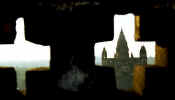 We arrived into Jhansi late at
night and found a basic hotel room with mercifully hot water and, luxury of
all luxuries, CNN. We were heading
for Orchha, a relatively small village set among a wonderful complex of
well-preserved palaces and temples, so the next morning hired a tuk-tuk to drive
us. We had read that it was a
peaceful and relaxing place to spend a couple of days and, feeling in need of
some rest, decided to stop here to enjoy the peace and quiet, together with some
decent food and accommodation.
We arrived into Jhansi late at
night and found a basic hotel room with mercifully hot water and, luxury of
all luxuries, CNN. We were heading
for Orchha, a relatively small village set among a wonderful complex of
well-preserved palaces and temples, so the next morning hired a tuk-tuk to drive
us. We had read that it was a
peaceful and relaxing place to spend a couple of days and, feeling in need of
some rest, decided to stop here to enjoy the peace and quiet, together with some
decent food and accommodation.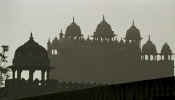
We opted for a room in the
government run hotel (a converted part of the old palace) and, feeling in need
of some creature comforts, decided on their Royal Apartment.
Perhaps luxurious in years gone by, it now was tired and worn.
But at least it was peaceful, and we spent
a leisurely day sightseeing around the palace grounds and climbing up onto the
old ramparts for spectacular views of the town and temples.
Khajuraho
Tuesday 18 January – Thursday
20 January 2000
We left Orchha and headed back to Jhansi to catch a local bus to Khajuraho, one of
India’s major attractions. Once a
great capital, Khajuraho is now a small town and despite all the tourist
attention, it is actually a relatively pleasant place.
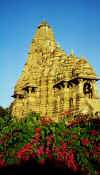 Only around 20 temples now
remain of the 85 that were originally built here between 950 and 1050 AD.
They were discovered by the British in 1840 amid dense jungle, but
restoration only began to take place in the early part of the 20th
century. The temples of Khajuraho,
like many of the temples across India, are a synthesis of architecture and
sculpture, but what makes them different is the profusion of stone carvings that
incorporate women and sex. Many
aspects appear in the artistic stonework – gods, goddesses, warriors,
musicians, animals – but these two elements appear over and over again.
Stone figures of apsaras (celestial maidens) appear on every
temple striking the kinds of poses we now associate with pin-up models.
Only around 20 temples now
remain of the 85 that were originally built here between 950 and 1050 AD.
They were discovered by the British in 1840 amid dense jungle, but
restoration only began to take place in the early part of the 20th
century. The temples of Khajuraho,
like many of the temples across India, are a synthesis of architecture and
sculpture, but what makes them different is the profusion of stone carvings that
incorporate women and sex. Many
aspects appear in the artistic stonework – gods, goddesses, warriors,
musicians, animals – but these two elements appear over and over again.
Stone figures of apsaras (celestial maidens) appear on every
temple striking the kinds of poses we now associate with pin-up models.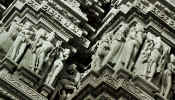
There are two principle groups
of temples: the western group is the main collection of temples contained within
a fenced enclosure that has been landscaped as a park; and the eastern group is scattered through the old village on the other side of town, where there is also
another walled enclosure containing some interesting Jain temples.
Khajuraho’s most impressive temple is the Kandariyamahadeva, built
in honour of the god Shiva and based on the shape of a cross.
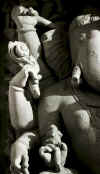


It was an interesting,
adult-only experience
wandering through these temple-complexes, built in the middle of
nowhere atop sandy plains. There
is significant speculation surrounding why they were built here and about the
subject matter, none of it very conclusive. A bit of a mystery,
really. But if nothing
else, they present exceptional examples of sandstone Indo-Aryan architecture and
sculpture and were definitely well worth the visit. Perhaps this was what
attracted the profusion of Japanese
tourists, so rarely encountered elsewhere in India; their zoom lenses were
getting quite a workout.